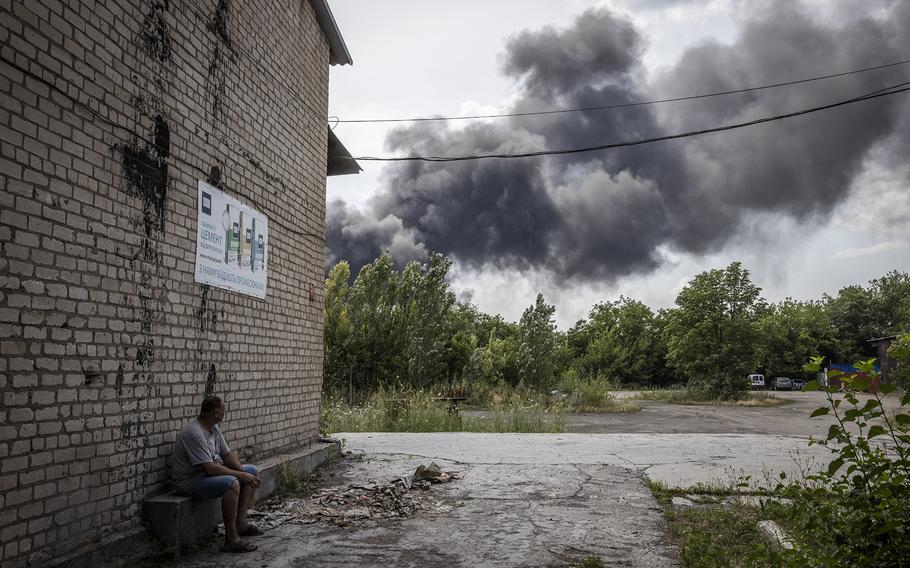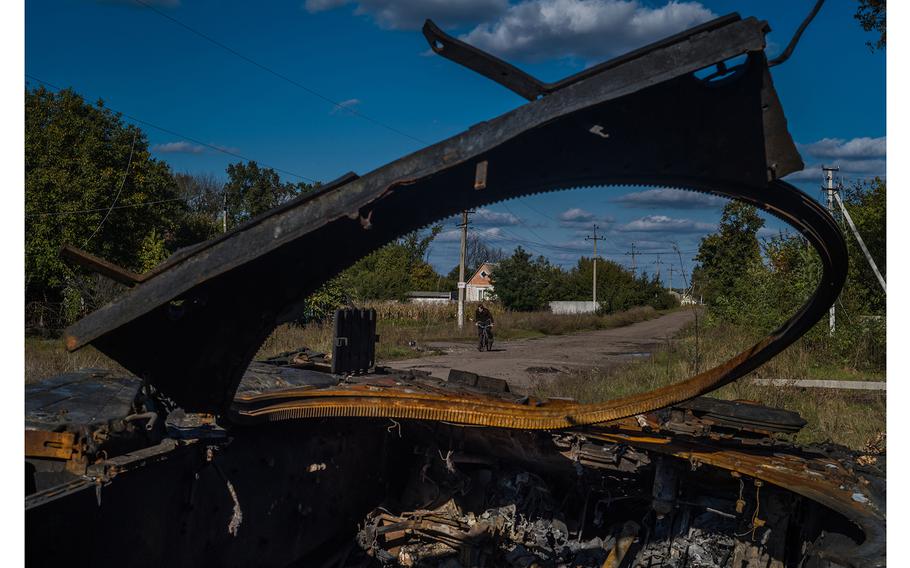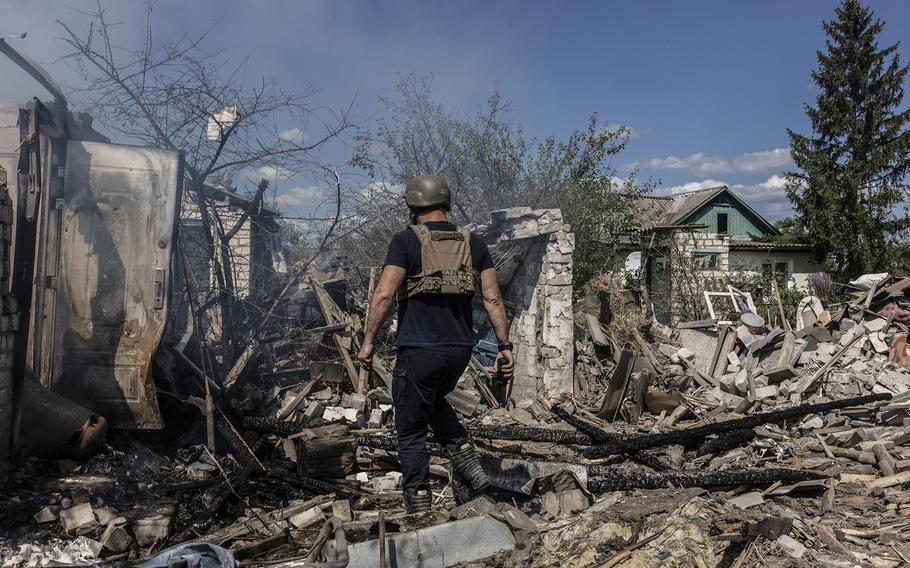
Smoke rises in an industrial area in Zaporizhzhia in southeastern Ukraine after a Russian missile strike in July, 2023. (Ed Ram for The Washington Post)
Three months into Ukraine’s inching counteroffensive, Russian occupying forces have largely been able to hold their positions, often by learning from past mistakes.
They have reconstituted decimated units, swapped in new ones and turned from sweeping attacks to the defense of heavily fortified front lines, showing that despite heavy losses, Moscow is willing to dig in for the long haul and wait for the resolve of Ukraine’s Western backers to diminish.
The relatively well-ordered defense marks a return to long-standing Russian military doctrine and a shift from the early days of the war, when Russia overextended its forces in lumbering advances into territory it could not hold, at great cost.
“It is an example of adaptation,” said Ian Matveev, a Russian military analyst for the Anti-Corruption Foundation, founded by imprisoned Russian opposition figure Alexei Navalny. “They are using their experience of this war,” he said, to fight Ukrainian forces to a grinding standstill.
While Ukrainian forces have claimed limited gains in a push to sever Russia’s southern land bridge to the Crimean Peninsula, critics say the influx of Western equipment, and months of training by NATO members to conduct complex offensive maneuvers, have not led to the large-scale success for which Washington was hoping, and that Ukraine continues to rely on a stale tactic: lobbing artillery at Russian positions.
A renewed Russian attack on the previously occupied and recaptured northeastern city of Kupyansk has shown that Russia still can advance. But the attack can be understood as part of the defensive strategy, experts say - a move to keep Ukrainian forces from concentrating in the south.
“They’re doing it because the front line in Ukraine is very long,” Andriy Besedin, the head of Kupyansk’s military administration and its de facto mayor, said in an interview. “They’re just throwing their soldiers into the meat grinder.”
Russia’s military suffered great losses amid chaotic advances last year, with some units wiped out almost entirely, according to U.S. assessments.
But it has been able to recuperate, despite signs of low morale and disorder in the upper echelons of military leadership following a June mutiny by Wagner Group mercenaries. The depleted ranks have been replenished, through a “partial mobilization” that called up hundreds of thousands of men, and by recruitment from prisons, a technique adapted from Wagner.
Britain’s Defense Ministry estimated in the spring that Russia could field roughly the same number of troops it did at the start of the invasion: some 200,000, divided among 70 combat regiments and brigades, organized under five administrative “districts,” defending front lines that stretch some 600 miles.
Roughly half of Russia’s forces are massed in the northeast, according to recent Ukrainian estimates, far from the center of the counteroffensive.
Before the war, Ukraine’s military numbered an estimated 250,000, with plans to expand. Both Russia and Ukraine have seen considerable casualties, with U.S. and European officials estimating earlier this year that as many as 120,000 Ukrainian soldiers had been killed or wounded in the war, as had some 200,000 Russian soldiers - figures that have only grown.
Traditional military theory suggests that an advancing force would need at least three times the number of soldiers defending to make gains.
“Everyone uses that number and everyone hates it,” said Mark Cancian, a retired Marine officer and defense expert at the Center for Strategic and International Studies, a Washington think tank. “But in a situation like this with prepared defenses, you need more than three to one. It could be six to one, 10 to one.”
Russian losses have been spread unevenly across its military: While Moscow threw some units or entire districts into the fray, it held others back. Russia’s Western Military District, designed as the country’s advanced force against NATO adversaries, suffered massively early in the war.
Units from that district, including the once highly regarded 1st Guards Tank Army and the Sixth Combined Army, are involved in the advance on Kupyansk, said Karolina Hird, a Russia analyst at the Institute for the Study of War, a Washington think thank. The depleted units appear to have been reconstituted with conscripts.
“They’re barely a shell of what they used to be,” Hird said, adding that the 1st Guards had retreated so quickly last year that they became the “largest tank donor to the Ukrainian army.”
However, Russia’s Southern Military District, which has assumed primary responsibility for defending occupied territory in the strategically important Zaporizhzhia region, was held in reserve earlier in the war and was able to meet Ukraine’s counteroffensive with fresh but experienced forces.
These soldiers spent months “digging in, preparing for the exact type of defensive operations” they are conducting, Hird said.
The Southern Military District, responsible within Russia for territory bordering Ukraine and Georgia, has been a “breeding ground” for innovation and has performed better than other districts, said Charles Bartles, a Russia analyst with the Foreign Military Studies Office, a research center at Fort Leavenworth, Kan.

A bicyclist approaches a destroyed Russian tank last October in Pisky Radkivsky in the Kharkiv region of eastern Ukraine. (Wojciech Grzedzinski/for The Washington Post)
Russia has largely sent motor rifle brigades - which comprise around 8,000 infantry troops, along with heavy weaponry such as tanks and artillery - to defend its front lines in the south. Its defense mixes inexperienced units made up of released convicts with more elite ones from the Russian navy and Spetsnaz, or special forces, according to open-source analysts.
The 64th Motor Rifle Brigade, part of the 35th Army from the Eastern Military District, has been reported in the first line of defenses near Orikhiv. The brigade, linked to apparent war crimes in the Kyiv suburb of Bucha at the start of the war, was given an honorary title by Russian President Vladimir Putin last year for “mass heroism and bravery.”
Russia uses special forces units to plug in as fast reinforcements, according to the open-source intelligence group Black Bird. Some soldiers from these groups, who report to Russian military intelligence, were airlifted to the front line during the beginning of the counteroffensive.
Among them: The 22nd Separate Spetsnaz Brigade, described in leaked U.S. military documents as having suffered high casualties, an attrition rate up to 95 percent, earlier in the war, in part because of Russia’s reliance on it for front-line operations. It is unclear how it could be back in even partial action so quickly - Spetsnaz units typically require years of training.
Even last year, Russian forces “were still thinking that they might go on the offensive again and capture large amounts or even all of Ukraine,” said Cancian. “Now they’re trying to hang on to what they have already occupied.”
In Zaporizhzhia, the southern district and the center of the counteroffensive, occupying troops have not made gains in a year. Instead, they spent months building layered fortifications.
The approach represents a return to a traditional precept of Russian military thinking: a focus on training for defensive operations out of fear of an attack from the West.
“Preparing these kinds of defensive positions is something that commanders understand and have had drilled into their head since they were cadets,” said Dara Massicot, a Russian military analyst at the Rand Corp., a U.S. think tank.
An April article in “Military Thought,” the journal of Russia’s military elite, appeared to offer a rare public admission that Russia’s emphasis on offense had cost it. Though the article did not mention Ukraine, it outlined a realistic, even pessimistic, tactic of defending key areas against a “superior” enemy.
Alexander Romanchuk, one of the co-authors, was at the time head of a military academy in Moscow. Since, he has assumed the defense against the counterattack in Zaporizhzhia.
The aim of Russia’s layered defensive lines is to slow and deplete Ukrainian forces. Even if they push through the front line, they must contend with fresh Russian forces entrenched in a second line, or third.
Russia’s heavy use of land mines is a key part of its defense. Russian troops use the ISDM Zemledeliye mine-laying system that scatters mines from rockets, allowing rapid re-mining of cleared areas, and use mined trenches and stacked mines to trick advancing forces.
Russian artillery units, also key to defense, are considered sophisticated, able to identify new targets and launch attacks in a matter of minutes.
While the Russian military may be able to stage a competent defense, there are signs that it still suffers from damaging shortages.
It is sometimes staging attacks at a platoon level, involving as few as three tanks and a few dozen troops, according to James Rand, a military analyst with a private intelligence firm Janes. The strategy, while sound, could indicate a lack of resources.
“They are getting very short on deployable armored vehicles,” Rand said. Open-source intelligence group Oryx said it had confirmed Russia’s loss of 2,296 tanks in the war - more than half the number with which it began.
After Wagner’s mutiny, Russia’s military leadership structure appears to remain muddled. Gen. Sergei Surovikin, a lauded military commander, was sidelined for his alleged sympathies with Wagner and removed as air force chief last month.
Wagner’s withdrawal removed as many as 20,000 experienced fighters from the battlefield. Experts say Wagner’s exit is evident in the hodgepodge mixture of troops who have replaced it in Ukraine’s east.

A firefighter works in the ruins of a home destroyed last month by Russian artillery in Kupyansk in the Kharkiv region. ()
Russia’s present strategy could face a new wave of challenges. While units such as the 58th Army were fresh when the counteroffensive began, it has been under attack for months, Massicot said. Russia appears willing to “grind the units down to the point where they’re no longer combat-capable.”
The unit’s commander announced last month that he had been forced from his position over criticism of this bloody approach.
Moscow could be playing an attritional waiting game, banking on depleting Ukraine’s ranks or for its backers to lose faith. However, some Ukrainian officials argue that Russia hasn’t given up on taking land and that Kupyansk is just the start.
“We clearly understand that the enemy has not abandoned his painful hopes of occupation of the entire region,” said Oleh Synyehubov, the governor of Kharkiv.
Some pro-Russian military figures seem to agree. Alexander Khodakovsky, a Kremlin-backed commander in the self-proclaimed Donetsk People’s Republic, wrote in a widely shared Telegram post last month: “You can’t win in defense.”
Anastacia Galouchka, Siobhán O’Grady, John Hudson, Laris Karklis and Júlia Ledur contributed to this report.